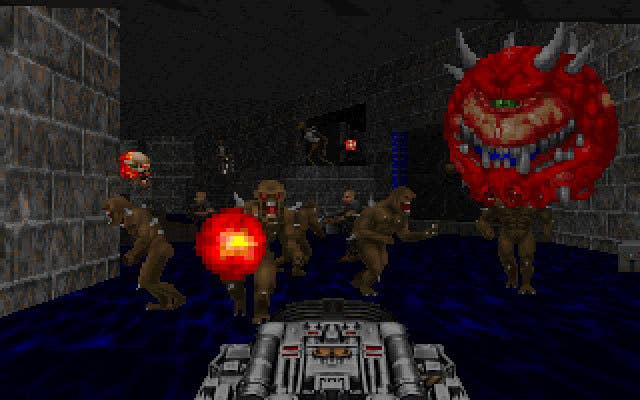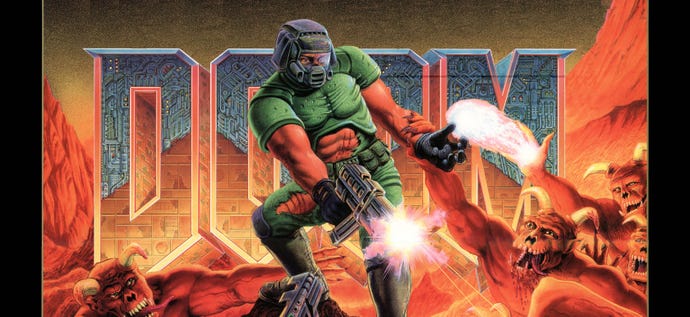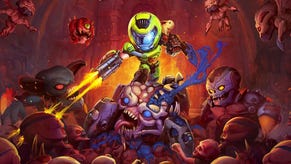USgamer Celebrates 20 Years of Doom
id Software's classic first-person shooter turns 20 today. Team USG shares its memories from back in the day.
This article first appeared on USgamer, a partner publication of VG247. Some content, such as this article, has been migrated to VG247 for posterity after USgamer's closure - but it has not been edited or further vetted by the VG247 team.
December 10, 1993 saw the release of a shareware PC game that would turn out to be one of the most important titles of all time: id Software's Doom.
At the time, it was clear that Doom was a top-quality title with an impressive new 3D engine and some immensely solid gameplay. But who could have predicted quite what an impact this unassuming little first-person shooter would have on both the industry as a whole and our own personal gaming careers?
In honor of the great game's 20th birthday, Team USG decided to share some favorite memories about Doom and what it means to them.
Pete Davison, News Editor
Ahh, Doom. Doom wasn't the first first-person shooter I played -- that dubious honor goes to Wolfenstein 3D -- but it was one that made a particularly big impression on me. It was one of the earliest games I can think of that had such a genuinely menacing, disturbing atmosphere that I found myself feeling legitimately scared by the experience; a game that was well worth ditching the crappy speakers you tended to get with sound cards in favor of a decent stereo setup with actual bass.
Of course, Doom's 2D-projected-into-3D maps and sprite-based enemies look somewhat laughable compared to today's technology, but at the time it was revolutionary for a number of reasons: for helping to popularize the first-person shooter genre, for showing other developers how atmosphere and horror was really done, and for being one of the most "open" games out there when it came to modding.
The popularity of modding Doom helped pave the way for modern PC games such as Skyrim today; infinitely expandable games that you can potentially play forever.
Pete

I was an active member of the Wolfenstein 3D modding community thanks to how easy it was to generate new maps for that game -- I even made $200 by having ten of my maps featured on the official expansion pack! -- but unfortunately, Doom modding proved to be somewhat more challenging and I could never quite get my head around it. That didn't stop me exploring other people's work, though; I have very fond memories of exploring hundreds of new maps, graphics mods and total conversions of the game that other people more talented than myself had put together. The popularity of modding Doom helped pave the way for modern PC games such as Skyrim today; infinitely expandable games that you can potentially play forever, so long as dedicated enthusiasts are continuing to make new content for it. And, like mods for many games today, a number of Doom mods ended up actually being better than the base game -- I have particularly fond memories of an Alien-inspired total conversion called Invasion that featured full animated intro and end sequences.
My most enduring memory of Doom, though? UK magazine PC Zone accidentally putting a pornographic mod on its cover-mounted CD that replaced the wall textures with… uhh… inappropriate images. They got in a bit of trouble for that, but to be fair, there were about a thousand other .WAD files on that disc so I'm not altogether surprised it got missed!
Jaz Rignall, Editorial Director
When Pete mentioned that it was DOOM’s 20th birthday, I paused for a second. Not because it seems like such a long time ago (which it is), but because I was sure I’d played it well before December 1993. And then I remembered why - Doom was one of the first big games to be released via shareware. Back then, I thought it was a crazy (but cool) idea to encourage people to copy a game and share it. But of course it wasn’t crazy at all - just a nascent version of the now-ubiquitous free-to-play business model that is so commonplace these days. The idea worked great for DOOM, because it went on to be a huge seller.
I played it almost exclusively at a friend’s house. He was a hardcore hacker/programmer and complete hardware nut, and his PC was phenomenal for its period. He was using graphics and sound cards when most people didn’t even know they existed, and spent a lot of time hacking drivers so that he could get games working exactly the way he wanted them to. So of course, he spent countless hours making Doom run at what was then ridiculous frame rates and top resolution. Of course, these days I’m sure it’d look like an explosion in a LEGO factory running at 20 FPS, but back then, this was the very pinnacle of PC gaming.
We knew every square millimeter of Doom. Specific routes through the game are still burned into my memory. I think maybe Pac-Man is the only other game that did that to me.
Jaz

We ended up playing the game to death, especially once he hacked his own driver so we could use a decent controller with it, and we knew every square millimeter of it. Specific routes through the game are still burned into my memory. I think maybe Pac-Man is the only other game that did that to me.
Two decades later, DOOM has become the legend it deserves to be. Its legacy is in the DNA of many of the biggest franchises of today. And whenever you say “first-person shooter,” just remember that before that term was invented in the late 90’s, everything that involved you looking down the barrel of a gun was called a “DOOM clone.”
Jeremy Parish, Senior Editor
When I went off to college in 1993, my parents offered to pay for half a car or half a computer. I opted for the latter, because I’m a nerd, I guess. I paid the other half with money I’d saved from a surprisingly well-paying high school job and went off to university as the proud owner of a new Macintosh, back when even low-end Macs were insanely expensive. It saw me through my first few months in fine style.
But then, toward the end of fall semester, I made the mistake of stopping by a friend’s dorm room where his roommate was playing some amazing, immersive, fast-paced, 3D shooter. The heavy metal album cover ambience of the graphics didn’t do much for me, but I was transfixed. How could a computer -- a Windows PC at that, a platform not at all known for graphical prowess! -- produce something so incredible-looking? “Envy” doesn’t begin to describe it.
I ended up playing some pretty fantastic games waiting for Doom: Spectre VR, Star Wars: Dark Forces and the Marathon Trilogy. In fact, by the time Doom finally limped its way over to Mac, I kind of didn't care any more.
Jeremy

Being a Mac owner tragically shut me out of Doom access for years; the game had a rocky road making its way to Apple systems, to the point that somehow Doom II ended up being ported before the original. But that tantalizing glimpse I saw inspired me to go hunting for whatever first-person experiences I could find for my poor little Mac. I ended up playing some pretty fantastic games waiting for Doom: Spectre VR, Star Wars: Dark Forces, and one of my all-time favorites, the Marathon Trilogy. In fact, by the time Doom finally limped its way over to Mac, I kind of didn’t care any more.
Which isn’t to say I don’t appreciate what the game accomplished, or that I can’t have a good time with it even now. It really cemented the good and bad of the first-person shooter genre, the unique vocabulary of the format that everyone else has built on over time. Plenty of others have expanded on what Doom presented (System Shock, Marathon, GoldenEye, Halo, Call of Duty, Half-Life, etc.) but no one has ever produced a work that had such profound impact on the genre. Doom wasn’t the first FPS, but it was the first that really and truly worked, and its importance had as much to do with the game’s internal design as its distribution method and the extensible format id used for the game’s file. Doom launched the shareware boom that led to today’s downloadable demos, and it created a game-modding culture that thrives even now.
I still wish I’d been able to play it when it was new, though.







